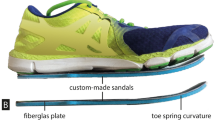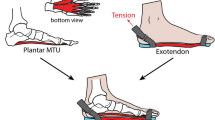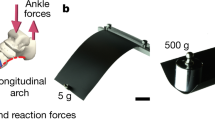Abstract
Until relatively recently, humans, similar to other animals, were habitually barefoot. Therefore, the soles of our feet were the only direct contact between the body and the ground when walking. There is indirect evidence that footwear such as sandals and moccasins were first invented within the past 40 thousand years1, the oldest recovered footwear dates to eight thousand years ago2 and inexpensive shoes with cushioned heels were not developed until the Industrial Revolution3. Because calluses—thickened and hardened areas of the epidermal layer of the skin—are the evolutionary solution to protecting the foot, we wondered whether they differ from shoes in maintaining tactile sensitivity during walking, especially at initial foot contact, to improve safety on surfaces that can be slippery, abrasive or otherwise injurious or uncomfortable. Here we show that, as expected, people from Kenya and the United States who frequently walk barefoot have thicker and harder calluses than those who typically use footwear. However, in contrast to shoes, callus thickness does not trade-off protection, measured as hardness and stiffness, for the ability to perceive tactile stimuli at frequencies experienced during walking. Additionally, unlike cushioned footwear, callus thickness does not affect how hard the feet strike the ground during walking, as indicated by impact forces. Along with providing protection and comfort at the cost of tactile sensitivity, cushioned footwear also lowers rates of loading at impact but increases force impulses, with unknown effects on the skeleton that merit future study.
This is a preview of subscription content, access via your institution
Access options
Access Nature and 54 other Nature Portfolio journals
Get Nature+, our best-value online-access subscription
$29.99 / 30 days
cancel any time
Subscribe to this journal
Receive 51 print issues and online access
$199.00 per year
only $3.90 per issue
Buy this article
- Purchase on Springer Link
- Instant access to full article PDF
Prices may be subject to local taxes which are calculated during checkout



Similar content being viewed by others
Data availability
All relevant processed data supporting the findings of this study are available as Source Data. Further data are available from the corresponding author upon reasonable request.
Code availability
All MATLAB and R code used to process and statistically analyse the data are available from the corresponding author upon reasonable request.
References
Trinkaus, E. & Shang, H. Anatomical evidence for the antiquity of human footwear: Tianyuan and Sunghir. J. Archaeol. Sci. 35, 1928–1933 (2008).
Kuttruff, J. T., DeHart, S. G. & O’Brien, M. J. 7500 years of prehistoric footwear from Arnold Research Cave, Missouri. Science 281, 72–75 (1998).
Shawcross, R. Shoes: An Illustrated History (Bloomsbury, 2014).
Sanders, J. E., Goldstein, B. S. & Leotta, D. F. Skin response to mechanical stress: adaptation rather than breakdown—a review of the literature. J. Rehabil. Res. Dev. 32, 214–226 (1995).
Kim, S. H. et al. Callus formation is associated with hyperproliferation and incomplete differentiation of keratinocytes, and increased expression of adhesion molecules. Br. J. Dermatol. 163, 495–501 (2010).
Hashmi, F., Nester, C., Wright, C., Newton, V. & Lam, S. Characterising the biophysical properties of normal and hyperkeratotic foot skin. J. Foot Ankle Res. 8, 35 (2015).
Abouaesha, F., van Schie, C. H. M., Griffths, G. D., Young, R. J. & Boulton, A. J. M. Plantar tissue thickness is related to peak plantar pressure in the high-risk diabetic foot. Diabetes Care 24, 1270–1274 (2001).
Menz, H. B. & Morris, M. E. Footwear characteristics and foot problems in older people. Gerontology 51, 346–351 (2005).
Hoffmann, P. The feet of barefooted and shoe-wearing peoples. J. Bone Joint Surg. Am. 3, 105–136 (1905).
D’Août, K. D., Pataky, T. C., De Clercq, D. & Aerts, P. The effects of habitual footwear use: foot shape and function in native barefoot walkers. Footwear Sci. 1, 81–94 (2009).
Johansson, R. S. Tactile sensibility in the human hand: receptive field characteristics of mechanoreceptive units in the glabrous skin area. J. Physiol. 281, 101–125 (1978).
Perry, S. D., McIlroy, W. E. & Maki, B. E. The role of plantar cutaneous mechanoreceptors in the control of compensatory stepping reactions evoked by unpredictable, multi-directional perturbation. Brain Res. 877, 401–406 (2000).
Johansson, R. S. & Vallbo, Å. B. Tactile sensory coding in the glabrous skin of the human hand. Trends Neurosci. 6, 27–32 (1983).
Löfvenberg, J. & Johansson, R. S. Regional differences and interindividual variability in sensitivity to vibration in the glabrous skin of the human hand. Brain Res. 301, 65–72 (1984).
Kennedy, P. M. & Inglis, J. T. Distribution and behaviour of glabrous cutaneous receptors in the human foot sole. J. Physiol. 538, 995–1002 (2002).
Wells, C., Ward, L. M., Chua, R. & Inglis, J. T. Regional variation and changes with ageing in vibrotactile sensitivity in the human footsole. J. Gerontol. An. Biol. 58A, 680–686 (2003).
Höhne, A., Ali, S., Stark, C. & Brüggemann, G. P. Reduced plantar cutaneous sensation modifies gait dynamics, lower-limb kinematics and muscle activity during walking. Eur. J. Appl. Physiol. 112, 3829–3838 (2012).
Stuart, M., Turman, A. B., Shaw, J., Walsh, N. & Nguyen, V. Effects of aging on vibration detection thresholds at various body regions. BMC Geriatr. 3, 1 (2003).
Frenette, B., Mergler, D. & Ferraris, J. Measurement precision of a portable instrument to assess vibrotactile perception threshold. Eur. J. Appl. Physiol. Occup. Physiol. 61, 386–391 (1990).
Hilz, M. J. et al. Normative values of vibratory perception in 530 children, juveniles and adults aged 3–79 years. J. Neurol. Sci. 159, 219–225 (1998).
Shun, C. T. et al. Skin denervation in type 2 diabetes: correlations with diabetic duration and functional impairments. Brain 127, 1593–1605 (2004).
Lafortune, M. A. & Hennig, E. M. Cushioning properties of footwear during walking: accelerometer and force platform measurements. Clin. Biomech. 7, 181–184 (1992).
Heidenfelder, J., Sterzing, T. & Milani, T. L. Systematically modified crash-pad reduces impact shock in running shoes. Footwear Sci. 2, 85–91 (2010).
Addison, B. J. & Lieberman, D. E. Tradeoffs between impact loading rate, vertical impulse and effective mass for walkers and heel strike runners wearing footwear of varying stiffness. J. Biomech. 48, 1318–1324 (2015).
Wallace, I. J., Koch, E., Holowka, N. B. & Lieberman, D. E. Heel impact forces during barefoot versus minimally shod walking among Tarahumara subsistence farmers and urban Americans. R. Soc. Open Sci. 5, 180044 (2018).
Marlowe, F. W. Hunter-gatherers and human evolution. Evol. Anthropol. 14, 54–67 (2005).
Althoff, T. et al. Large-scale physical activity data reveal worldwide activity inequality. Nature 547, 336–339 (2017).
Meyer, P. F., Oddsson, L. I. E. & De Luca, C. J. Reduced plantar sensitivity alters postural responses to lateral perturbations of balance. Exp. Brain Res. 157, 526–536 (2004).
Nurse, M. A. & Nigg, B. M. The effect of changes in foot sensation on plantar pressure and muscle activity. Clin. Biomech. 16, 719–727 (2001).
Schlee, G., Sterzing, T. & Milani, T. L. Effects of footwear on plantar foot sensitivity: a study with Formula 1 shoes. Eur. J. Appl. Physiol. 106, 305–309 (2009).
Perry, S. D. Evaluation of age-related plantar-surface insensitivity and onset age of advanced insensitivity in older adults using vibratory and touch sensation tests. Neurosci. Lett. 392, 62–67 (2006).
Strzalkowski, N. D. J., Triano, J. J., Lam, C. K., Templeton, C. A. & Bent, L. R. Thresholds of skin sensitivity are partially influenced by mechanical properties of the skin on the foot sole. Physiol. Rep. 3, e12425 (2015).
Merkel, P. A. et al. Validity, reliability, and feasibility of durometer measurements of scleroderma skin disease in a multicenter treatment trial. Arthritis Rheum. 59, 699–705 (2008).
Hedrick, T. Software techniques for two- and three-dimensional kinematic measurements of biological and biomimetic systems. Bioinspr. Biomim. 3, 034001 (2008).
Riley, P. O., Paolini, G., Della Croce, U., Paylo, K. W. & Kerrigan, D. C. A kinematic and kinetic comparison of overground and treadmill walking in healthy subjects. Gait Posture 26, 17–24 (2007).
R Core Team. R: A Language and Environment for Statistical Computing. http://www.R-project.org/ (R Foundation for Statistical Computing, 2015).
Bates, D., Mächler, M., Bolker, B. & Walker, S. Fitting linear mixed-effects models using lme4. J. Stat. Softw. 67, 1–48 (2015).
Lenth, R. V. Least-squares means: the R package lsmeans. J. Stat. Softw. 69, 1–33 (2016).
Acknowledgements
We thank M. Sang, J. Jemutai, N. Keter, the teachers and students of Pemja and AIC Chebisas School, C. Diggins, L. Kaufman, R. Doerfler, D. Schmidt, E. Schoeck, P. Schulze and M. Venkadesan. This research was funded by the American School of Prehistoric Research (Peabody Museum, Harvard University).
Peer reviewer information
Nature thanks Kristiaan D’Août and William L. Jungers for their contribution to the peer review of this work.
Author information
Authors and Affiliations
Contributions
D.E.L., T.J.D., N.B.H., T.L.M., B.W. and C.Z. designed the experiments; all co-authors except C.Z. collected the data; N.B.H., D.E.L., T.L.M., B.W. and C.Z. analysed the data; D.E.L., T.J.D., N.B.H., T.L.M, B.W. and C.Z. wrote the paper.
Corresponding author
Ethics declarations
Competing interests
The authors declare no competing interests.
Additional information
Publisher’s note: Springer Nature remains neutral with regard to jurisdictional claims in published maps and institutional affiliations.
Extended data figures and tables
Extended Data Fig. 1 Skin stiffness.
a, Comparison of skin stiffness in usually shod (blue; n = 46) and usually barefoot (red; n = 34) individuals. Data are mean + 1 s.d. Significant differences were calculated after log-transforming the data (two-tailed Welch’s two-sample t-test, *P = 0.03). No significant difference was found between usually shod and usually barefoot individuals at the first metatarsal head (P = 0.09; two-tailed Welch’s two-sample t-test). For test statistics, see Extended Data Table 3. b, c, Relationship between skin hardness and skin stiffness at the heel (b; n = 79) and the first metatarsal head (c; n = 79). Squares indicate men and circles indicate women. d, e, Relationship between callus thickness and skin stiffness at the heel (d; n = 74) and the metatarsal head (e; n = 74). r and P values are from Pearson product–moment correlation association tests. Lines represent linear regression model fits for the two variables.
Extended Data Fig. 2 Skin material properties across regions.
a, Relationship between callus thickness and skin hardness. b, Relationship between callus thickness and skin stiffness. Data points indicate measurements from the heel (green circle) and first metatarsal head (light-blue square) in all participants. Dashed lines indicate the ordinary least squares regressions for the heel, and dash–dot lines indicate ordinary least squares regressions for the metatarsal head. Similar relationships between callus thickness and skin hardness are evident across regions of the foot, which indicates a consistent effect of callus thickness on skin hardness. By contrast, different relationships between callus thickness and skin stiffness occur in the two regions of the foot, which suggests that stiffness measurements are influenced by subdermal tissues.
Extended Data Fig. 3 Impact peak force results.
a, Relationship between callus thickness and impact peak force (BW) in usually barefoot (red; n = 29 individuals, n = 70 steps) and usually shod (blue; n = 28 individuals, n = 44 steps) Kenyan individuals. Box plots depict comparisons between usually barefoot and usually shod individuals. b, Relationship between callus thickness and impact peak force (BW) in US individuals (n = 22 individuals) when barefoot (yellow), wearing uncushioned shoes (orange) and wearing cushioned shoes (red). Likelihood ratio tests carried out on model variance from linear mixed-effects models presented in Extended Data Tables 5, 7 indicate that there is no significant relationship between callus thickness and impact peak force and no effect of footwear-use category or footwear condition (P > 0.05). For all box plots, boxes represent interquartile ranges, middle bars represent median values, whiskers extend to the most extreme data point ± 1.5× the interquartile range and more extreme data points are indicated by circles.
Supplementary information
Supplementary Information
This file contains Supplementary Methods 1-3, Supplementary Tables S1-S3 and a Supplementary Discussion.
Rights and permissions
About this article
Cite this article
Holowka, N.B., Wynands, B., Drechsel, T.J. et al. Foot callus thickness does not trade off protection for tactile sensitivity during walking. Nature 571, 261–264 (2019). https://doi.org/10.1038/s41586-019-1345-6
Received:
Accepted:
Published:
Issue Date:
DOI: https://doi.org/10.1038/s41586-019-1345-6
This article is cited by
-
Potential predictive effect of mechanical properties of the plantar skin and superficial soft tissue, and vibration perception on plantar loading during gait in individuals with diabetes
BMC Musculoskeletal Disorders (2023)
-
Assessing reliability and validity of different stiffness measurement tools on a multi-layered phantom tissue model
Scientific Reports (2023)
-
Morphological and evolutionary insights into the keystone element of the human foot’s medial longitudinal arch
Communications Biology (2023)
-
Myofascial Tissue and Depression
Cognitive Therapy and Research (2022)
-
Running barefoot leads to lower running stability compared to shod running - results from a randomized controlled study
Scientific Reports (2021)
Comments
By submitting a comment you agree to abide by our Terms and Community Guidelines. If you find something abusive or that does not comply with our terms or guidelines please flag it as inappropriate.



